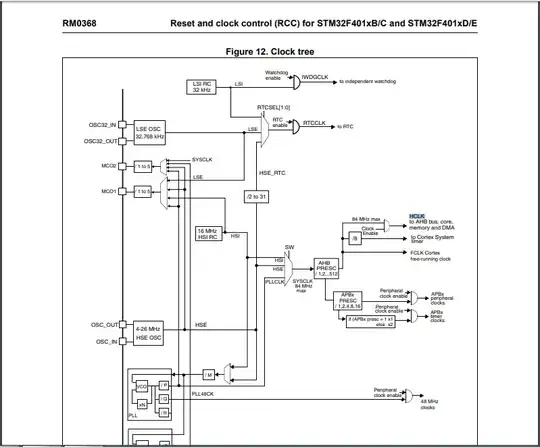I just started using the STM32 F401VC Discovery Evaluation board and I'm trying to get the maximum GPIO toggling frequency without assambler. So my tought process is following:
The code I was planning to use is:
#include "stm32f4xx_gpio.h"
#include "stm32f4xx_rcc.h"
#include "stm32f4xx.h"
#include "stm32f4xx_spi.h"
void initializeGreenLed(void){
GPIO_InitTypeDef GPIO_InitStructure;
RCC_AHB1PeriphClockCmd(RCC_AHB1Periph_GPIOD, ENABLE);
GPIO_InitStructure.GPIO_Pin = GPIO_Pin_12;
GPIO_InitStructure.GPIO_Mode = GPIO_Mode_OUT;
GPIO_InitStructure.GPIO_Speed = GPIO_Speed_50MHz;
GPIO_InitStructure.GPIO_OType = GPIO_OType_PP;
GPIO_InitStructure.GPIO_PuPd = GPIO_PuPd_NOPULL;
GPIO_Init(GPIOD,&GPIO_InitStructure);
}
int main(void)
{
//RCC_CFGR;
initializeGreenLed();
//initialiseSysTick();
GPIO_SetBits(GPIOD,GPIO_Pin_12);
while(1)
{
GPIO_ToggleBits(GPIOD,GPIO_Pin_12);
}
}
The max pin toggle frequency I get is around 230 KHz. Since the MCU can be run at 84 MHz, I have a feeling, that it's possible to increase the max toggle frequency beyond 230 KHz.
So I tought that I need to change/modify the clock source for RCC_AHB1Periph_GPIOD in RCC_AHB1PeriphClockCmd(RCC_AHB1Periph_GPIOD, ENABLE);. For that I used the STM32 F4 reference manual.  So my plan was to use PLLCLK as SYSCLK. The PLLCLK would be sourced from 8MHz HSE.
So my plan was to use PLLCLK as SYSCLK. The PLLCLK would be sourced from 8MHz HSE.
Browsing through YouTube, found a nice example:
#include "stm32f4xx_gpio.h"
#include "stm32f4xx_rcc.h"
#include "stm32f4xx.h"
#include "stm32f4xx_flash.h"
void initializeGreenLed(void){
GPIO_InitTypeDef GPIO_InitStructure;
RCC_AHB1PeriphClockCmd(RCC_AHB1Periph_GPIOD, ENABLE);
GPIO_InitStructure.GPIO_Pin = GPIO_Pin_12;
GPIO_InitStructure.GPIO_Mode = GPIO_Mode_OUT;
GPIO_InitStructure.GPIO_Speed = GPIO_Speed_100MHz;
GPIO_InitStructure.GPIO_OType = GPIO_OType_PP;
GPIO_InitStructure.GPIO_PuPd = GPIO_PuPd_NOPULL;
GPIO_Init(GPIOD,&GPIO_InitStructure);
}
int main() {
//---------------------------down is clc stuff---------------------------
RCC_DeInit();
ErrorStatus Errsts;
RCC_HSEConfig(RCC_HSE_ON);
Errsts = RCC_WaitForHSEStartUp();
if (Errsts == SUCCESS) {
//external clc is ok
RCC_PLLConfig(RCC_PLLSource_HSI, 8, 336, 2, 7);
RCC_PLLCmd(ENABLE);
RCC_GetFlagStatus(RCC_FLAG_PLLRDY == RESET);
FLASH_SetLatency(FLASH_Latency_5);
RCC_HCLKConfig(RCC_SYSCLK_Div1);
RCC_PCLK1Config(RCC_HCLK_Div4);
RCC_PCLK2Config(RCC_HCLK_Div2);
RCC_SYSCLKConfig(RCC_SYSCLKSource_HSE);
initializeGreenLed();
while(1){
GPIO_SetBits(GPIOD,GPIO_Pin_12);
}
}
else {
//External clc no ready
while(1);
}
}
But it doesn't work, as in it just stays in one state.
So I have two questions:
- Why isn't my code working?
- If my abovementioned strategy is incorrect, how to increase the toggle frequency beyond 230 KHz?